How bitSmiley Unlocks Global Liquidity for BTCFi
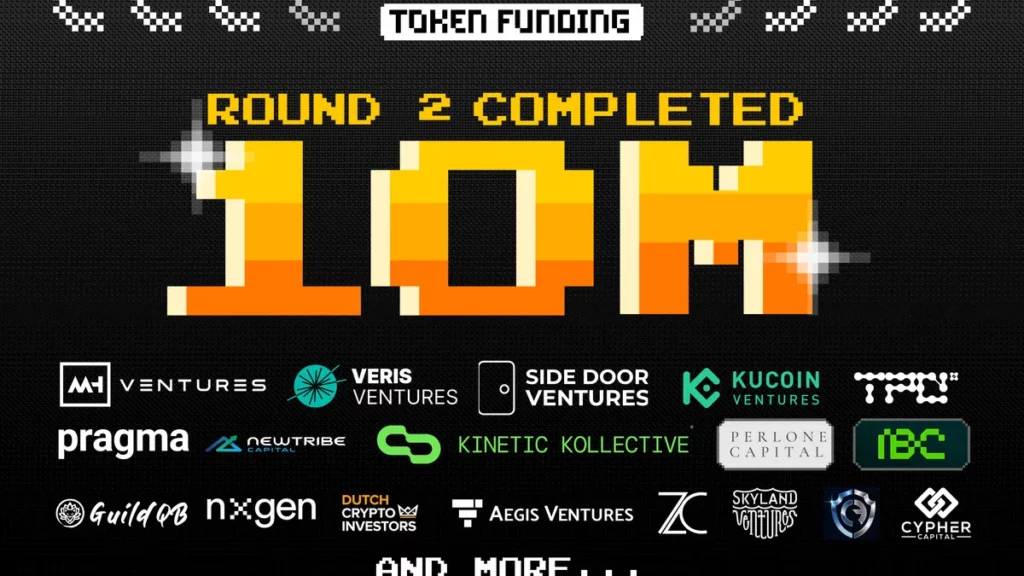
On October 28, the Bitcoin-native stablecoin project bitSmiley announced the successful completion of a $10 million Series B funding round, with participation from several well-known investment firms, including MH Ventures and Skyland Ventures. This funding marks a significant advance in expanding liquidity for decentralized applications on Bitcoin and diversifying use cases.
With its past project data, bitSmiley has firmly established itself as the “leader in BTC over-collateralized stablecoins,” poised to inject new vitality into the BTCFi sector. Furthermore, as the U.S. election approaches, regardless of the outcome, the past statements of both Trump and Harris suggest a forthcoming crypto-friendly environment, which could further drive the development of the BTC ecosystem, including BTCFi, and facilitate the mainstream adoption of cryptocurrencies.
For regular market users focused on yields, the upcoming listing of the bitSmiley token on Bybit Launchpad and Gate Startup Prime promises exciting returns, potentially multiplying tenfold.
As the meme craze sweeps the crypto market, can the BTC ecosystem capitalize on this momentum to usher in a new bull market cycle? In this article, Coindarwin will analyze the situation with bitSmiley as a focal point for readers.
BTCFi: A Rising Narrative in the Bull Market as BTC Reaches New Heights
With a short-term easing of tensions in the Middle East and a consensus among industry insiders that “Trump’s election as U.S. President in 2024 could propel BTC to new highs and initiate a new crypto bull market,” the BTC price recently surged above $73,000. This positive momentum creates a favorable environment for the BTC ecosystem, offering “vast opportunities and potential.” The BTCFi sector, seen as a key contributor to a new liquidity feast for the crypto industry, holds significant promise.
According to data released by CryptoCompare and CoinGecko, the BTCFi market reached a valuation of $10 billion in 2023. DefiLlama predicts that by 2030, the BTCFi market size could grow to approximately $1.2 trillion (notably, this figure includes BTC’s Total Value Locked in the DeFi ecosystem and the market size of Bitcoin-related financial products and services).
In recent years, the growth potential of the BTCFi market has attracted increasing participation from institutional investors. Traditional finance (TradFi) entities like Grayscale, BlackRock, and JPMorgan have begun to engage in the BTCFi market. This institutional participation not only brings substantial capital inflows, enhancing market liquidity and stability, but also increases market maturity and regulatory compliance, elevating the overall recognition and trustworthiness of the BTCFi market.
The reasons behind this trend can be summarized in three main points:
- Strong Investment Demand: The demand for BTC investments has surged, with net inflows into BTC spot ETFs continuously increasing. BTC’s market cap recently approached 60%, a new high since 2021. Additionally, following a price rebound to $69,000, the proportion of profitable BTC addresses reached 96%, likely drawing in more speculative capital.
- Shifting Market Narratives: After experiencing several industry waves such as DeFi, GameFi, and NFTs, Ethereum’s innovation momentum has waned. The once-promising “Ethereum killer,” Solana, has become a battleground for meme coins. The TON ecosystem has also entered a lull following its meme projects. With expectations for new BTC price highs, BTCFi is set to be a pivotal narrative that unlocks more liquidity through innovations like BRC-20 inscriptions.
- Ecosystem Pathway Reuse: Previously, the BTC ecosystem was hindered by a lack of programmable interoperability, making it less scalable compared to Ethereum. However, with the emergence of the BRC-20 protocol, the BTC ecosystem has opened new developmental pathways. By borrowing from Ethereum’s developmental model, BTCFi can activate global liquidity starting from the DeFi sector, facilitating a broader flow of funds. This is one of the reasons many Real-World Asset (RWA) projects, asset management funds, and public companies are betting on the BTC ecosystem.
Notably, Tether’s USDT and MakerDAO’s over-collateralized stablecoin DAI, established in 2014, laid a solid foundation for Ethereum’s DeFi Summer, which is crucial for BTCFi’s rise.
In summary, stablecoins in the BTC ecosystem play several critical roles in the development of the BTCFi sector:
- Introducing More Liquidity: They facilitate bi-directional exchanges of on-chain assets across different networks.
- Expanding BTC Ecosystem Applications: By utilizing stablecoins, the BTC ecosystem can engage in lending, futures, derivatives, and other activities.
- Connecting the BTCFi Value Chain and Accelerating Ecosystem Development: Stablecoins serve as the lifeblood of blockchain networks, reconstructing the value chain within the BTC ecosystem. Projects, products, and applications from different ecological niches can interact efficiently, thereby speeding up the development of the BTC ecosystem.
Currently, the landscape of stablecoin projects in the BTC ecosystem presents a “one leading, many following” scenario, with bitSmiley’s bitUSD leading the way.
Most other projects are still in early stages without launched stablecoin products, primarily falling into two categories:
- In the Initial Funding Stage: This includes the BTC liquidity protocol and stablecoin issuer Yala, which completed an $8 million seed funding round on October 10, led by Polychain Capital and Ethereal Ventures, with participation from Galaxy, Anagram, Amber Group, and others. Another project, Plasma, which is EVM-compatible, raised $3.5 million on October 18, led by Bitfinex and backed by various venture capital firms.
- In Extremely Early Stages or Just “Paper Plans”: An example is RUSD, an over-collateralized stablecoin issued under the Stable++ protocol that launched its mainnet on October 18. As of October 25, its Total Value Locked (TVL) was only $658,000, with fewer than 250,000 RUSD minted. As for Tether, its last update regarding plans to reissue USDT on the BTC ecosystem’s RGB protocol was back in August 2023, with little follow-up since, possibly indicating their existing business profits are sufficient for now, leading to no immediate plans to enter the BTC stablecoin competition.
In comparison to slower-moving new and established entrants like Plasma, Seal, Yala, and Tether, bitSmiley has already made its strategic moves, with bitUSD becoming a cornerstone product in the BTCFi ecosystem landscape.
Entering bitSmiley: The “Cornerstone Player” in the BTCFi
As a key player in the BTC ecosystem, often referred to as the “MakerDAO of the BTC ecosystem” and the “leading stablecoin project in the BTC ecosystem,” bitSmiley has established itself as a “cornerstone player” in the BTCFi ecosystem. This is largely due to its launch of the first native over-collateralized stablecoin in the BTC ecosystem—bitUSD.
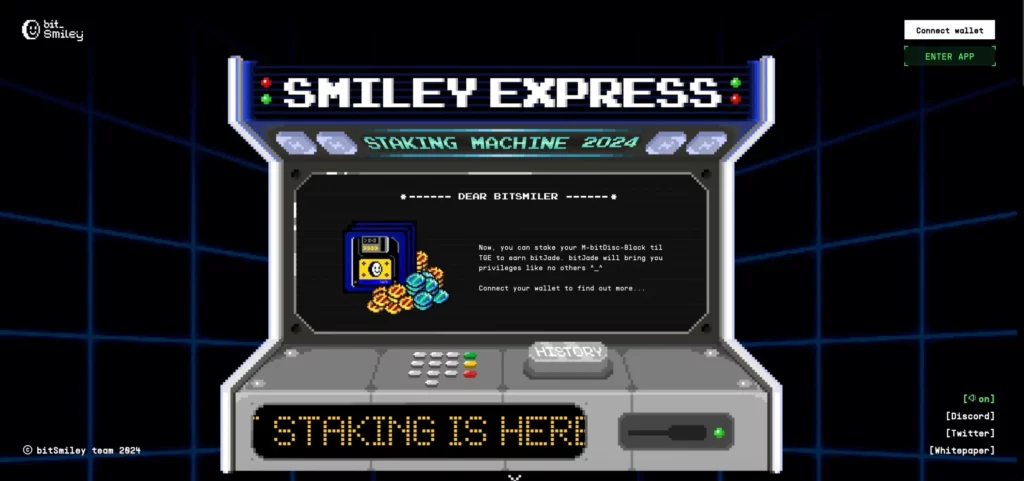
bitUSD aims to address the most critical and core issue within the BTC ecosystem: asset yield and value circulation. Currently, it has over 20,000 on-chain wallet addresses (as of the time of writing, there are 21,575) and a Total Value Locked (TVL) exceeding $30 million, with more than 40 ecosystem partnerships. It is undoubtedly leading in terms of financing scale, performance data, and ecosystem cooperation.
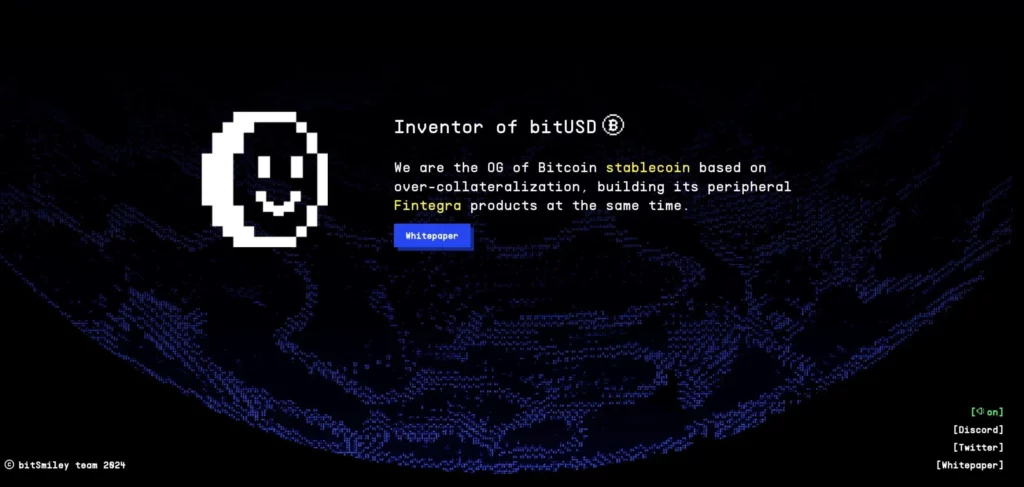
Specifically, the advantages and details of bitSmiley and bitUSD include the following:
1. bitUSD: A Native Over-Collateralized Stablecoin of the BTC Ecosystem
Before the emergence of bitSmiley, the unified settlement currency within the BTC ecosystem was BTC and SATS, which were heavily influenced by market fluctuations. However, this situation significantly improved with the introduction of bitUSD.
According to information from the official website, bitSmiley has built the BTC ecosystem’s DeFi protocol standard—bitRC-20—based on the BRC20 protocol. On this foundation, it created the native over-collateralized stablecoin, bitUSD.
Notably, bitRC-20 can be seen as an extension of BRC20, making it compatible and supporting minting and burning operations to meet the needs for stablecoin issuance and redemption. Users can over-collateralize BTC to redeem bitUSD, with each circulating bitUSD token backed by corresponding over-collateralized assets, and all transactions of bitUSD are publicly transparent on the Bitcoin blockchain.
The overall minting logic is as follows: 1) Users over-collateralize BTC on the Bitcoin mainnet; 2) Oracles relay the corresponding information to bitSmileyDAO for consensus verification; 3) After consensus is reached, bitSmileyDAO communicates the minting of bitUSD to the Bitcoin mainnet validators, completing the minting process. The redemption logic is the opposite; when users redeem collateral, the corresponding bitUSD is burned.
Based on this information, we can understand that bitUSD has properties similar to Ethereum’s over-collateralized stablecoins, providing value storage, a medium of exchange, a unit of account, and standards for deferred payments.
In practical applications, multiple BTC ecosystem lending projects, including ENZO Finance, Avalon, and PanterFi, have opened support for bitUSD (as collateral or borrowing bitUSD). Additionally, bitUSD can participate in various Launchpad platforms such as Merlin Starter, Pumpad, and BRC Starter. Within the bitSmiley protocol, bitUSD can also be used to settle debts, such as paying stability fees or loan interest.
As for bitSmiley’s liquidation method, it involves conducting an English auction of future platform revenues as debts, with profits, after deducting basic operating costs, prioritized for creditor repayment. This method is superior to traditional token inflation repayment methods, avoiding the dilution of token holder interests.
Building upon its core stablecoin, bitSmiley can further expand and develop DeFi products aligned with BTC’s technical roadmap, creating peer-to-peer lending supported by its stablecoin and layering advanced derivatives like insurance and CDS, thus introducing new play styles to BTCFi.
With the introduction of bitUSD, users can directly use it as a stable currency within BTC ecosystem applications. Future products available for user participation include the native trustless lending protocol bitLending, the derivatives protocol bitInsurance, the Bitcoin-native AMM bitCow, and the consensus governance organization bitSmileyDAO, composed of bitUSD holders (who can participate in decentralized governance, including adjusting collateral types, LTV ratios, and other key protocol parameters, as well as emergency shutdowns in response to uncontrollable attacks).
Additionally, the design of bitSmiley products features retro pixel elements, with its official logo being a pixel smiley face, which not only has high recognizability but also aligns well with the current meme trend that has gained much popularity. As a result, the project community and the crypto market have produced numerous related derivative works that are highly engaging and have significant viral potential.

2. Ecosystem Collaboration Landscape
As a BTC ecosystem stablecoin protocol, bitSmiley has already formed partnerships with over 40 high-quality project teams for various levels of integration.
Notable projects include well-known BTC Layer 2 networks such as BitLayer, Merlin Chain, BEVM, Bob, and B² Network, as well as oracle projects like Pyth Network and Apro Oracle, and L1 networks such as ZetaChain, as well as the star BTC ecosystem project Babylon.
Importantly, as the first real over-collateralized stablecoin project in the Bitcoin ecosystem, bitUSD has avoided a series of adverse events such as de-pegging and liquidation during its first six months of operation, highlighting bitSmiley’s strong competitive advantage compared to other competitors.
Furthermore, the integration with ZetaChain will help bitUSD extend liquidity across any blockchain network, increasing its liquidity scale and making it the “first project to mint over-collateralized stablecoins using BTC L1 network as collateral.”
According to the official collaboration documents, the specific technical implementation details involve ZetaChain and bitSmiley introducing a new protocol layer built on Bitcoin’s Taproot upgrade using Tapscript, allowing users to easily deposit native BTC and mint bitUSD stablecoins; developers can also unlock BTC liquidity in DeFi through general applications on ZetaChain.
This innovation breaks the 80-byte limit seen in previous OP_RETURN-based cross-chain transactions, bringing new upgrades to ZetaClient, enabling the use of inscriptions to witness data and increase byte size while mapping the user’s BTC wallet and EVM wallet hexadecimal addresses for a smooth one-click operation experience.
The integration with Babylon will expand the types of collateral for bitUSD to various BTC LST assets, which is expected to capture a significant portion of its TVL in the future, achieving a win-win in the ecosystem.
Additionally, DeFi projects, GameFi projects, BTC ecosystem native wallets, and AI projects are also among bitSmiley’s partners, showcasing the richness of its ecosystem landscape.
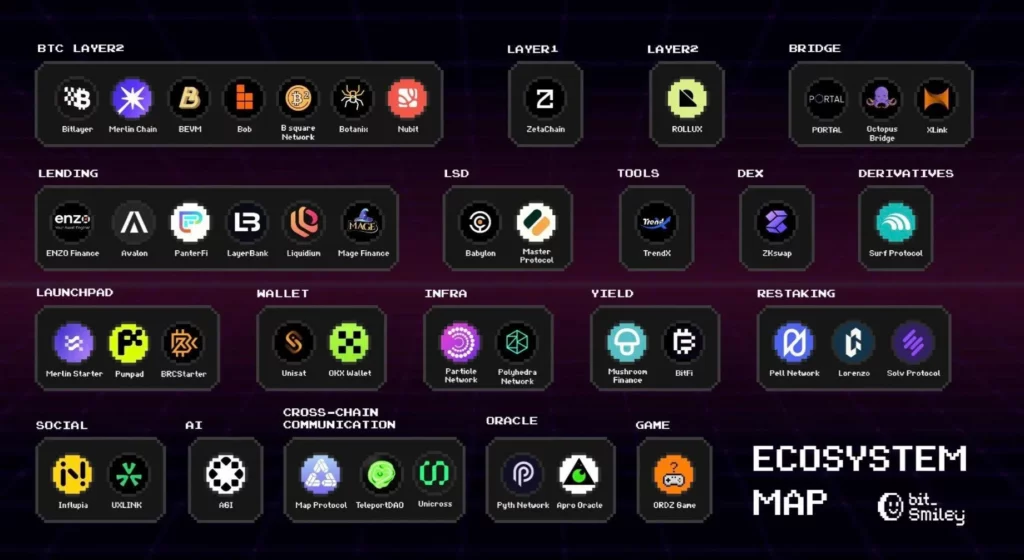
3. Project Achievements
Notably, prior to the recent announcement of its second round of financing amounting to $10 million, bitSmiley had completed its first round of token financing in January this year, with the specific amount unknown. This round was led by OKX Ventures and ABCDE, with numerous angel investors from institutions such as CMS Holdings, Foresight Ventures, LK Venture, Silvermine Capital, Waterdrip Capital, Blockchain Founders Fund, ArkStream Capital, 7 UpDAO, CGV FoF, Momentum Capital, Candaq Funtech, Comma 3 Ventures, and Delphi Digital also participating.
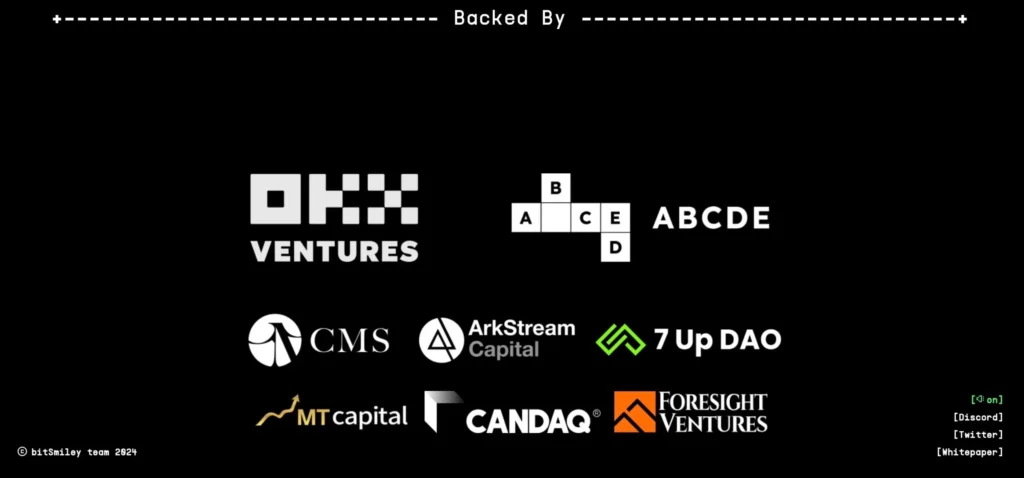
Moreover, the previous bitDisc-Black series of inscription NFTs by bitSmiley saw participation from over 40,000 addresses in the minting process; within five hours of launching on the OKX NFT Marketplace, the trading volume surpassed 20 BTC, with a floor price reaching as high as 0.036 BTC (approximately $2000+), making it one of the leading projects in the BTC ecosystem with wealth generation effects.
It is worth noting that bitSmiley’s previous airdrop activities had relatively high thresholds, such as the testnet being invite-only and the airdrop of test tokens only targeting bitDisc-Black (commonly known as black card) holders or highly active community users verified through multiple checks.
The participation threshold for its mainnet points activity was also set at 0.1 BTC, which is the minimum collateral amount for minting bitUSD. Thus, bitSmiley has gathered a group of active builders and loyal users within the BTC ecosystem, laying a solid foundation for future development.
4. Future Development Plans
According to previous financing news, bitSmiley aims to provide robust liquidity support based on over-collateralization and native BTC lending mechanisms, striving to offer users a safer and more transparent on-chain DeFi experience within the BTC ecosystem. Its ongoing development of seamless cross-chain transaction capabilities is expected to unlock the ceiling for the BTCFi sector and further expand the market size of the BTC ecosystem.
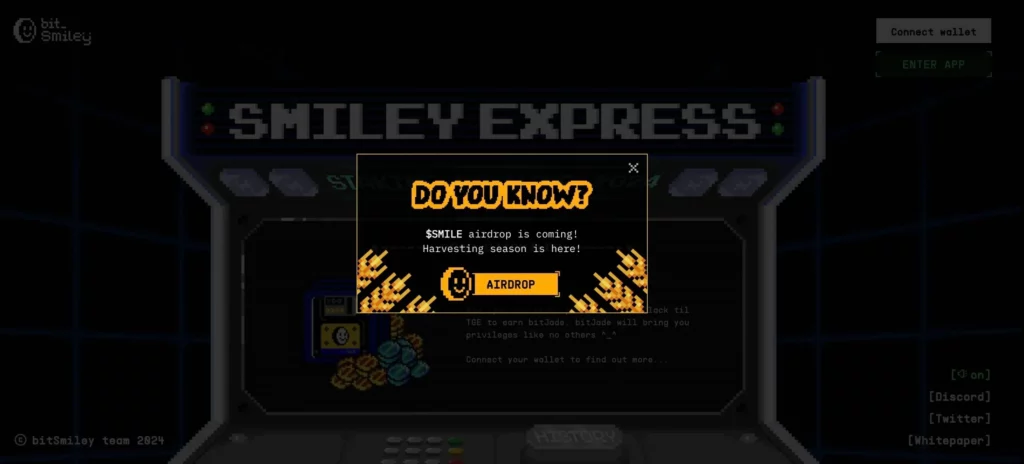
According to its official announcement, the bitSmiley Token Generation Event (TGE) is also set to take place soon. Its token, SMILE, has a total supply of 210,000,000 tokens and offers various utilities, including governance, participation in surplus auctions, discounts on stablecoin fees, and priority liquidation. Of the total supply, 3% has been locked for bitDisc-Black staking rewards, which will be distributed based on the number of bitJade tokens held by users. The official website has opened up staking reward queries.
Importantly, as mentioned at the beginning of the article, the SMILE token is about to launch on Bybit Launchpad and Gate Startup Prime for its Initial Exchange Offering (IEO). This year, Bybit has hosted 35 IEOs with an average peak return of 20 times. Based on bitSmiley’s project data, this could reach a peak return of 15-25 times, with average returns starting from 10 times.
Gate Startup Prime is considered a “flagship product,” with only 6 out of 279 startup projects this year qualifying as Prime, accounting for about 2.15%. Additionally, SMILE will be the first Prime project on Gate after a five-month hiatus, highlighting the importance of bitSmiley and the recognition it has received from exchanges, showcasing the robust momentum of the BTCFi sector.
As bitSmiley co-founder J Yee previously stated, bitSmiley will further optimize the infrastructure of BTCFi, expand its team size, and accelerate the launch of innovative features, aiming to promote broader applications of BTC in the DeFi field.
Conclusion: bitUSD May Become a Key Lever for BTCFi Bull Market
According to data from DefiLlama, the total TVL of MakerDAO, the largest over-collateralized stablecoin issuer in the Ethereum ecosystem, is $4.44 billion, with over 500,000 on-chain wallet addresses. In contrast, bitSmiley, firmly positioned as the leader in the BTC ecosystem’s over-collateralized stablecoin sector, still has significant potential for future development.
With the support of bitUSD, the value circulation system within the BTCFi sector is becoming increasingly mature. Combined with the existing favorable market conditions, it may become a key lever for igniting the BTC ecosystem’s bull market.
After all, compared to MakerDAO, which uses Ethereum as collateral, bitSmiley has chosen the “digital gold” BTC as its collateral—an asset with a higher market capitalization, better liquidity, and greater demand. Undoubtedly, the gradual expansion of the BTCFi sector will also drive rapid growth in bitSmiley’s TVL, and its SMILE token is likely to follow in the footsteps of MakerDAO’s MKR, creating wealth miracles comparable to the “up to 50 times crazy increase” seen during MKR’s launch.
There are always those who say that if they could go back in time, they would seize the wealth opportunities presented by tokens like Ethereum, UNI, and MKR. Now, with bitSmiley’s bitUSD emerging as the “native over-collateralized stablecoin leader in the BTCFi sector,” whether one can seize this opportunity depends on the subjective choices of each market user.